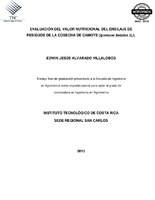Evaluación del valor nutricional del ensilaje de residuos de la cosecha de camote (Ipomoea batatas (L)).
Resumen
The present work aimed to evaluate the use of chopped harvest residues of sweet potatoes that are unused commercial and conventionally (foliage and tubers of third grade, i.e. residues) by means of the technique of microsilages and its use in feed for ruminants. The work was made with the sweet potato planting by products of the Bouregat variety that was three months old, in plots of the Instituto Tecnológico de Costa Rica, district of Florencia, San Carlos, province of Alajuela.
By the means of microsilages, the effect of different proportions of fodder (footstalk, leaf and stem) with sweet potato (tuber) on the nutritional value of the silage was evaluated. Analyses were performed at the Laboratorio de Análisis Agronómicos of the Escuela de Agronomía of the Instituto Tecnológico de Costa Rica. PVC pipe microsilages of 4" with a capacity up to 3 kg of mixture corresponding to each treatment were used. Fodder:tuber feed mixtures were made with ratios of 100:0; 75:25; 50:50; 25:75; and 0:100, treatments for T1 , T2 , T3 , T4 and T5 respectively. During this process, the fluid loss (effluent) and internal temperature parameters were evaluated. At the end of the period, the microsilages were opened and sampled to evaluate the quality, nutritional value, fermentation quality, organoleptic properties, pH, PC, NDF and ADF of the silage.
As for the organoleptic properties it was obtained that all treatments are acceptable as proved by the pH values obtained which showed no significant differences and whose values were 4,72; 5,68; 4,11; 3,9; and 3,69% for the treatments T1, T2, T3, T4 and T5, respectively. For the variable temperature no significant differences were found, average temperatures obtained were 26,69; 27,00; 23,81; 26,60 and 26,83°C for the treatments T1, T2, T3, T4 and T5, respectively. Regarding the effluent variable significant differences presented, whose mean values were 126,47; 335,33; 261,60; 335,33 and 631,37 ml for the treatments T1, T2, T3, T4 and T5, respectively. For the PC, NDF, ADF and digestibility variables, significant differences were found whose mean values obtained were 15,34; 9,22; 9,22; 7,38 and 5,52% for PC. NDF 56,34; 46,94; 36,11; 24,59 and 33,69%. ADF 54,25; 40,35; 29,57; 17,40 and 7,63%. Digestibility 54,43; 64,9; 75,50; 90,20 and 97,83% for the treatments T1, T2, T3, T4 and T5, respectively for each variable.
Descripción
Proyecto de graduación (Licenciatura en Ingeniería en Agronomía) Instituto Tecnológico de Costa Rica, Escuela de Ingeniería en Agronomía, 2015
Compartir
Métricas
Colecciones
El ítem tiene asociados los siguientes ficheros de licencia:



